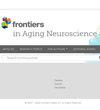白质高密度与认知功能不匹配患者的动态功能网络连通性
IF 4.1
2区 医学
Q2 GERIATRICS & GERONTOLOGY
引用次数: 0
摘要
目的脑小血管疾病(CSVD)患者的白质高密度(WMH)与认知功能障碍密切相关。然而,WMH 的严重程度与认知障碍并不完全一致。本研究旨在探讨认知匹配和不匹配患者WMH动态功能网络连通性(dFNC)的差异,从定量的角度更好地理解其潜在机制。对 rs-fMRI 数据进行预处理,然后进行 dFNC 分析,以获得 dFNC 指标。比较不匹配组和匹配组不同状态下的 dFNC 和 dFNC 指标,分析 dFNC 指标与认知功能的相关性。最后,为了分析不匹配组和匹配组之间差异的原因,我们在 uAI Discover 系统的帮助下量化了每位患者的 CSVD 影像特征。通过 dFNC 分析,我们发现状态 2 的分数时间(FT)和平均停留时间(MDT)在 "I 型匹配 "和 "I 型错配 "之间存在显著差异;状态 1 和 4 的 FT 在 "II 型匹配 "和 "II 型错配 "之间存在显著差异。相关性分析表明,在各种认知功能中,CSVD 患者的 dFNC 指标与执行功能和信息处理速度相关。通过定量分析,我们发现 "I型匹配 "和 "I型错配 "患者的血管周围间隙数量和双侧颞叶内侧萎缩(MTA)得分有显著差异,而 "II型匹配 "和 "II型错配 "患者的左侧MTA得分有差异:I型影响高阶网络,可能与血管周围间隙的数量和脑萎缩有关,而II型影响初级网络,可能与脑萎缩和受教育年限有关。本文章由计算机程序翻译,如有差异,请以英文原文为准。
Frontiers | Dynamic functional network connectivity in patients with a mismatch between white matter hyperintensity and cognitive function
ObjectiveWhite matter hyperintensity (WMH) in patients with cerebral small vessel disease (CSVD) is strongly associated with cognitive impairment. However, the severity of WMH does not coincide fully with cognitive impairment. This study aims to explore the differences in the dynamic functional network connectivity (dFNC) of WMH with cognitively matched and mismatched patients, to better understand the underlying mechanisms from a quantitative perspective.MethodsThe resting-state functional magnetic resonance imaging (rs-fMRI) and cognitive function scale assessment of the patients were acquired. Preprocessing of the rs-fMRI data was performed, and this was followed by dFNC analysis to obtain the dFNC metrics. Compared the dFNC and dFNC metrics within different states between mismatch and match group, we analyzed the correlation between dFNC metrics and cognitive function. Finally, to analyze the reasons for the differences between the mismatch and match groups, the CSVD imaging features of each patient were quantified with the assistance of the uAI Discover system.ResultsThe 149 CSVD patients included 20 cases of “Type I mismatch,” 51 cases of Type I match, 38 cases of “Type II mismatch,” and 40 cases of “Type II match.” Using dFNC analysis, we found that the fraction time (FT) and mean dwell time (MDT) of State 2 differed significantly between “Type I match” and “Type I mismatch”; the FT of States 1 and 4 differed significantly between “Type II match” and “Type II mismatch.” Correlation analysis revealed that dFNC metrics in CSVD patients correlated with executive function and information processing speed among the various cognitive functions. Through quantitative analysis, we found that the number of perivascular spaces and bilateral medial temporal lobe atrophy (MTA) scores differed significantly between “Type I match” and “Type I mismatch,” while the left MTA score differed between “Type II match” and “Type II mismatch.”ConclusionDifferent mechanisms were implicated in these two types of mismatch: Type I affected higher-order networks, and may be related to the number of perivascular spaces and brain atrophy, whereas Type II affected the primary networks, and may be related to brain atrophy and the years of education.
求助全文
通过发布文献求助,成功后即可免费获取论文全文。
去求助
来源期刊

Frontiers in Aging Neuroscience
GERIATRICS & GERONTOLOGY-NEUROSCIENCES
CiteScore
6.30
自引率
8.30%
发文量
1426
期刊介绍:
Frontiers in Aging Neuroscience is a leading journal in its field, publishing rigorously peer-reviewed research that advances our understanding of the mechanisms of Central Nervous System aging and age-related neural diseases. Specialty Chief Editor Thomas Wisniewski at the New York University School of Medicine is supported by an outstanding Editorial Board of international researchers. This multidisciplinary open-access journal is at the forefront of disseminating and communicating scientific knowledge and impactful discoveries to researchers, academics, clinicians and the public worldwide.
 求助内容:
求助内容: 应助结果提醒方式:
应助结果提醒方式:


